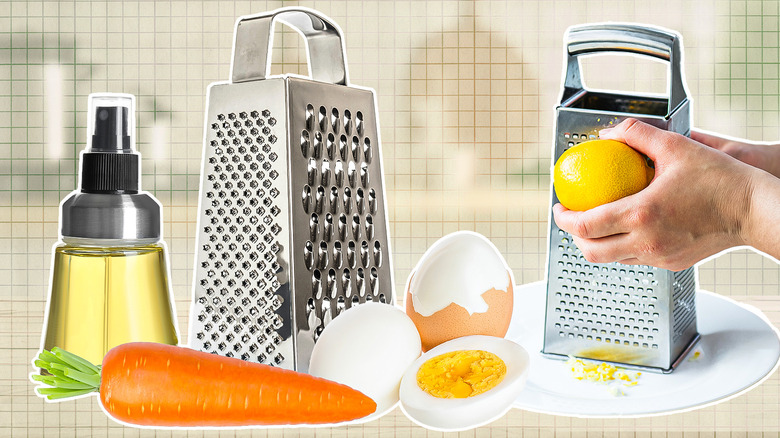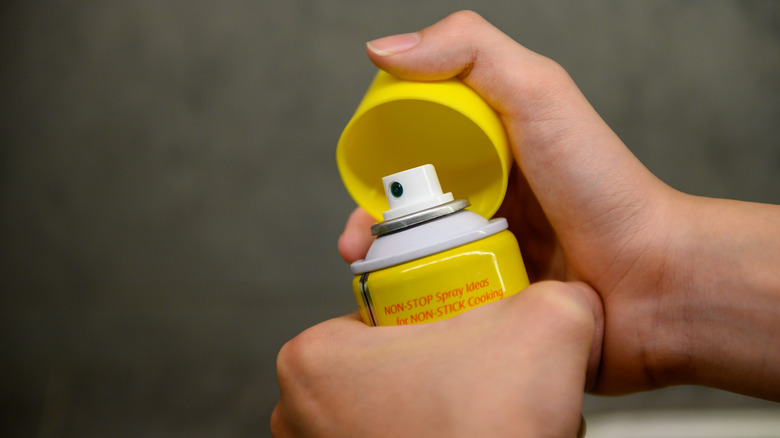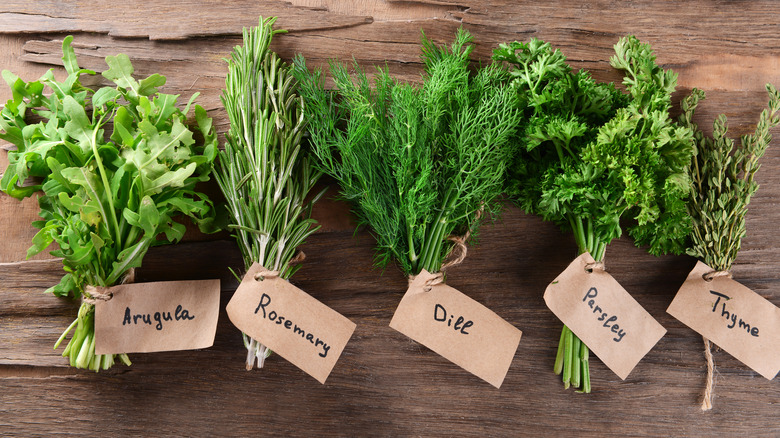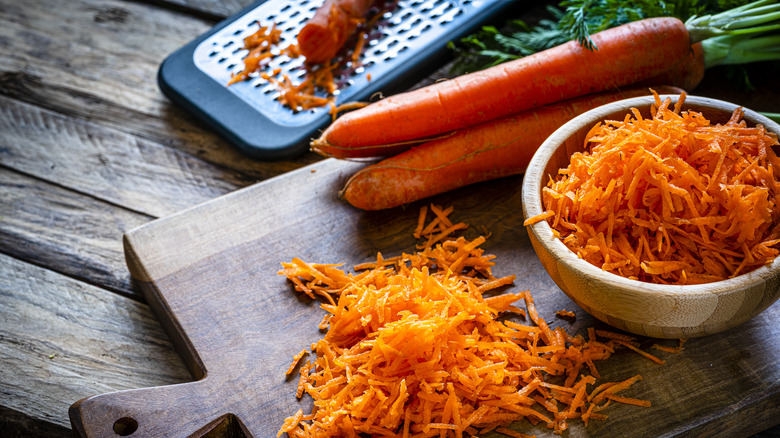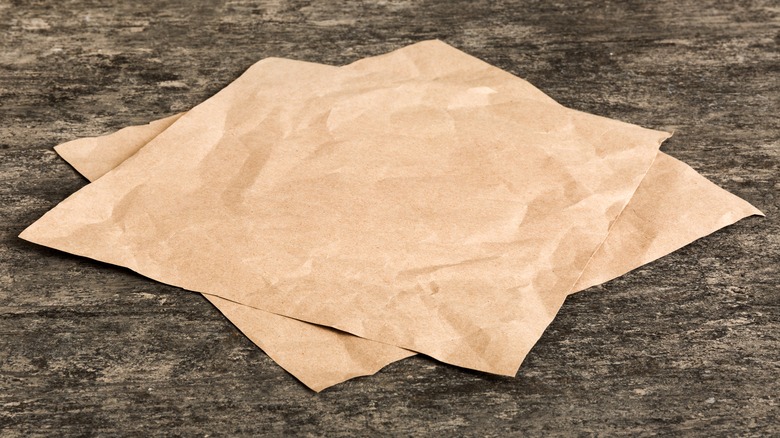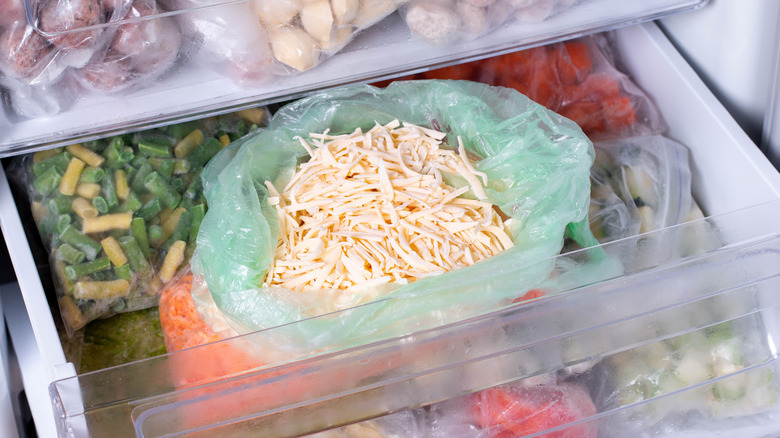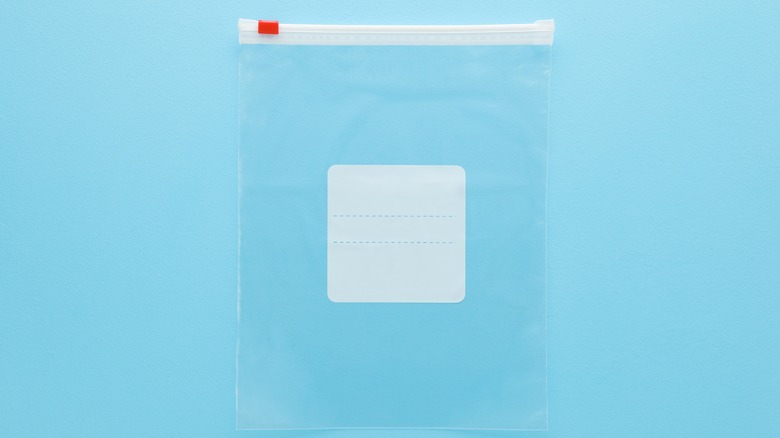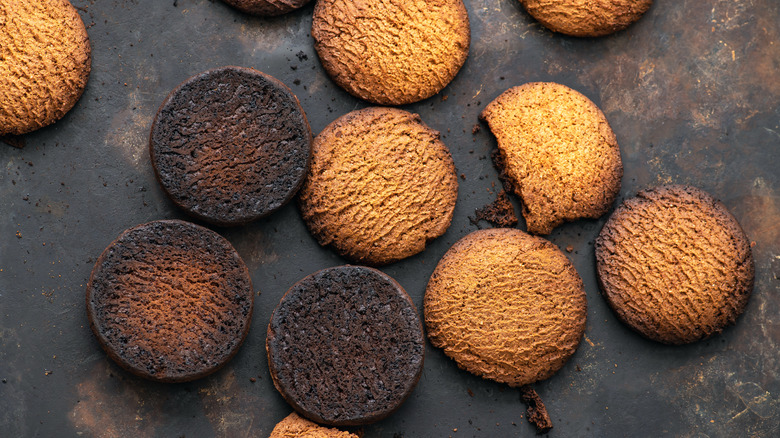12 Cheese Grater Hacks You Didn't Know You Needed
Freshly grated cheese is far superior to the pre-grated stuff you buy from the store. Chefs and choosy customers prefer it because it is more flavorful than the pre-shredded option, is fresher, lacks added chemicals used to prevent clumping, and winds up being significantly less expensive. Still, shredding cheese at home often seems a bit labor-intensive, tiresome, and, of course, messy.
Fortunately, there are a few hacks that'll make using a cheese grater significantly easier from start to finish. From preventing unwanted mess to streamlining storage to minimizing effort and cleanup times, you won't believe all the simple tricks that make using a cheese grater incredibly manageable. A cheese grater is also a wonderful tool for more than just cheese. With a trusty grater by your side, you can execute a handful of hacks that make prepping a world of other ingredients beyond easy.
To create a list of amazing cheese grater hacks, I sifted through Reddit forums, TikTok videos, cooking sites, chef recommendations, home cook blogs, and more. Along the way, I uncovered quite a few game-changing tips and tricks that just might make you rethink how you use your cheese grater.
Spray the grater with cooking oil to prevent sticking
Even with all the benefits associated with shredding cheese yourself, the mess left behind on a grater can be enough to make some people simply skip it. After all, who really wants to scrub a sharp, potentially hazardous, sponge-shredding cheese grater? Sure, soaking it in water is a definite help, and some graters may even be dishwasher safe, but once you try this cooking spray hack, something tells us you'll never look back.
Fortunately, cooking spray is all you need to prevent unnecessary cheese buildup in the small holes of a cheese grater. Simply apply a light coating to both sides of your cheese grater (inside and out for a box grater), and proceed like normal. Just as it does when you use it to bake, the cooking oil prevents sticking, allowing the cheese to fall off the metal sides effortlessly. When you are done shredding, the grater is also incredibly easy to clean with a quick rinse and a bit of soap. It almost sounds too good to be true, but luckily, it's not. It even works well for soft cheeses, which often give graters the most issues.
Turn a box grater on its side for easier manipulation
It's possible we aren't using our box cheese grater the correct way. Instead of placing them up and down with the large hole at the bottom, it can be turned on its side. Then, you are able to shred cheese using horizontal movements, not vertical. Supposedly, this allows you to use your body weight for added pressure, effectively making shredding easier and quicker. It also puts less strain on your hands while you work. When you are done grating, it also means you can simply move the entire grater and dump out the finished product where you want with ease. It's a handy transport system and grating hack all wrapped into one.
The downside to this cheese grater hack is that lower-quality box graters are not designed to be used this way, so the added pressure may lead to faster deterioration of the seams. Plus, the bottom side of the grater that is on the cutting board or counter will likely get scratched or possibly wear down faster than desired. Even so, it seems many people genuinely prefer this method. Ensure the grater you use is fairly heavy-duty if you want to make this your go-to method. While some people on Reddit are not 100% sold on this idea, it is pretty handy, so we recommend trying it and deciding for yourself.
Grater holes can de-stem fresh herbs
If you want to strip fresh herbs from their stems but hate how tedious of a task it can be, this next hack is for you. All you have to do is run each stem of a fresh herb through a large hole in a cheese grater, and viola. The stems come out the other side, and the leaves are left behind for you to use however you like. This quick and easy hack eliminates the need to pick each leaf off of a stem individually, making the process virtually effortless. Best of all, you can use it for all kinds of different herbs like parsley, dill, rosemary, mint, and more. Cilantro can also be de-stemmed this way, but we think you should stop throwing out cilantro stems because they are just as flavorful as the leaves.
In a matter of seconds, you can de-stem sprigs of Italian parsley, curly parsley, cilantro, spearmint, and rosemary by simply pulling them through one of the large holes in a box grater. Overall, it's an unbelievably speedy trick and kind of amazing.
Your grater is a shortcut for vegetable prep
Many people keep a box grater in their kitchen just for cheese, but they are actually much more versatile than that. They make a fantastic tool for grating all kinds of vegetables, like onions, zucchini, potatoes, carrots, and other root veggies. Grating vegetables is much faster than dicing them into small bits. They also allow you to create julienne-style cuts without the need for a mandoline or painstakingly trying to do it by hand, which, let's face it, is pretty tricky (even for a professional chef). When you're done, the shredded bits allow you to easily incorporate vegetables into salads, stir-fry dishes, and more.
Graters are also fantastic for prepping tomatoes with less mess. They quickly break down the tomato flesh and remove the skins in one quick motion. If you are making marinara from scratch, this simple hack quickly puts you miles ahead. Just make sure to rinse the grater as soon as you are done to ensure cleaning won't set you back again.
Graters can also be used to break down hard-boiled eggs. Just like vegetables, they create a crumbly texture perfect for an elevated egg salad, on top of avocado toast, in sandwiches, or as a garnish on green salads.
Hack your way to easier food collection and storage
You can do a couple of things to streamline cheese storage and containment when shredding. Once you hear what they are, you may be kicking yourself for not trying them before. They almost feel like they should be common sense, but somehow they're not.
The first hack is simply placing a square of parchment paper underneath the grater while you work. This technique helps contain potential mess underneath and allows you to pick up the entire pile and transfer it to a recipe or container for storage. It also ensures not even a single shred of cheese is left behind. A plate could work in much the same way, but it doesn't allow for nearly as smooth of a transfer.
The second super easy storage hack is to slide a resealable bag over the bottom of a box grater before you begin. When you do, it prevents unnecessary mess and sets you up for effortless storage. The bag should encircle the entire base but still leave plenty of room for you to execute the grating motion. You'll still be able to set it flat on a countertop, too. When you are done, all you have to do is pick up the grater, allow the cheese to fall into the bag, and it's ready for storage or immediate use with no mess left behind.
Your grater is an excellent substitute for a microplane
In addition to quickly de-stemming fresh herbs, your grater is the perfect tool to help you make light work of an array of other flavorful recipe additions. Your grater makes a wonderful substitute for a microplane. From zesting citrus peels to grating fresh ginger, garlic, cinnamon sticks, and nutmeg, it makes otherwise tough spices more accessible. If you've ever wondered if you can substitute dried versions of these flavors because chopping or dusting tiny bits is extremely difficult, your grater is the solution. It allows you to keep all the best, most potent flavors of fresh ingredients without all the perceived hassle of tedious extraction.
Aside from the fairly obvious ingredients listed above, your grater can also be used to add bouillon to a dish that needs an instant flavor boost. A small amount of bouillon provides deep flavors without having to simmer a dish in broth for hours. When you grate it, it also allows you to fine-tune the taste in small increments. Finally, grated bouillon enables you to only use a small amount without creating extra waste. Graters are also perfect for making breadcrumbs. They have to be pretty crispy, but finely shredding bread is super quick and easy with help from a box grater.
Your grater is the solution to the easiest ground meat
As you probably know by now, your cheese grater is ready to step in and hack all kinds of ingredients, not just cheese. One of the more surprising ways you can use it is to make ground meat. Most people probably haven't thought about making ground meat at home because you can easily buy the pre-made version, but once you find out how easy it is to do at home, you might change how you do things. After all, ground and shredded meat open up a world of fun recipes like burgers, meatballs, shredded chicken recipes, and much more.
If you want to use your grater to shred meat, make sure it is sturdy and extra sharp. Then, use it just like you would with a block of cheese, but swap out the dairy product for meat. We also recommend putting the grater on a plastic cutting board to help contain the mess and keep things sanitary. After shredding meat, proper sanitation is vital to prevent cross-contamination and promote food safety. It is essential that meat juices don't spread to other foods, and they must be used or stored properly to avoid possible food poisoning. Always wash your grater exceptionally well after shredding meat.
Freeze soft cheese for 30 minutes before grating
If you've ever tried to grate a soft cheese like mozzarella, we wouldn't be surprised if you wound up cursing your grater somewhere along the way. While freshly grated soft cheese is undeniably delicious, it is notoriously tricky to shred because of its mushy consistency. Not only does it compress, making it challenging to apply enough pressure, but it also gets stuck in all the holes and crevices and crumbles at rapid speeds. As a result, you wind up with a considerable amount of waste and a pointless effort.
Luckily, freezing soft cheese is the quick, easy solution to all your grating problems. Placing a block of fresh mozzarella cheese in the freezer for 15 to 30 minutes should be plenty. You want the cheese to be more rigid than it is at refrigerated temperatures but not so hard that it is actually frozen. It would probably still shred when frozen, but it will be much more difficult and is less than ideal for putting on a dish immediately because it'll potentially lower the temperature. Try this hack just once, and you'll wish you had known about it and tried it sooner.
Grate in both directions for speedier results
Many people place cheese on a grater's surface and move it downwards over the large protruding holes and their sharp edges. Then, they pick it up and repeat the motion until they have the correct amount of cheese. However, grating an ingredient in both directions is the key to lightning-fast results. The edges are typically sharp enough that sliding something across them in either direction produces similar results. There's a chance some of you already do this without thinking about it because it is easier to maintain consistent contact on the surface of a grater. But for everyone who doesn't, prepare to be amazed.
It sounds a little obvious, but grating in both directions cuts the time needed to achieve the task in half. You probably only spend a few minutes grating items for any particular recipe anyway, but reducing the time needed to cook by even just a tiny amount goes a long way when making an elaborate meal. We'll take the wins where we can.
Use half of a lemon for nearly effortless cleaning
We all know cleaning a cheese grater can be daunting, especially if you leave ingredients to harden and dry in the holes and crevices. In fact, cleaning a box grater can be so tricky that you may consider not even using it. Thankfully, there is a super simple, effective way to minimize cleaning issues on even the smallest graters: Lemons. Lemons make cleaning a grater virtually effortless. Plus, they leave behind a pleasant citrusy scent.
To clean your cheese grater the easy way, cut a lemon in half. Then, put the flesh side of one half on the surface of your grater and make grating motions, just like you would with cheese. To finish, rinse it off with hot water and watch as all the debris washes away. It's that easy. Aside from the cleaning potential, using half a lemon also helps preserve your dish sponge. Instead of the grater holes shredding your sponge to oblivion, the lemon takes a beating. Since the lemon just goes in the trash when you are done anyway, it's an acceptable loss.
Eliminate the need to clean your grater with a plastic bag
The final cheese grater cleaning hack we are going to divulge is a tad controversial. Some people love it, some not so much. Either way, we thought we would tell you what it is and let you decide for yourself.
We recommend placing a sturdy plastic storage bag over your cheese grater and grating foods on top. Supposedly, the sharp edges are large enough that you will still be able to shred things through the bag. When you are done, all you have to do is slide the bag off and put your grater away. There is no need to wash. Sounds fantastic, right? Well, yes and no.
This method seems pretty wonderful at face value, but it has us wondering about the plastic taste and if it would transfer to the food you are grating. In addition, if you press too hard and rip the bag, something tells us it would be practically impossible to ensure all the tiny plastic particles have been removed from the food. Lastly, it is pretty wasteful, creating unnecessary additional trash and extra cost.
Use your grater to remove the bottom of burnt cookies
If you accidentally leave your homemade cookies in the oven for a couple of minutes too long, all is not lost. Before you toss them in the trash, you can try salvaging them with your cheese grater. As long as the tops of the cookies still look good and aren't overly brown, you should be able to grate off the bottom layer without destroying them in the process. Sure, they may not be perfect when you are done, but you'd have to examine one to tell the difference before touching the bottom side.
Your grater is also helpful for other baking tasks, like evenly distributing butter through a pastry or pie crust recipe. You'll have to freeze the butter first, but grating it works like a charm. You don't have to worry about leaving it to sit out to soften, either. The super small pieces formed by your grater will warm up quickly.
Finally, your grater is the ideal tool for creating the perfect tempered chocolate. The small grated chunks melt much easier, leading to significantly improved results overall. Even if you are not tempering chocolate, your grater is perfect for shredding it. Once shredded, you can garnish all kinds of desserts, ice cream, and sweet breakfast treats like pancakes and waffles with the swirls. They also taste yummy on s'mores, yogurt, and more.
